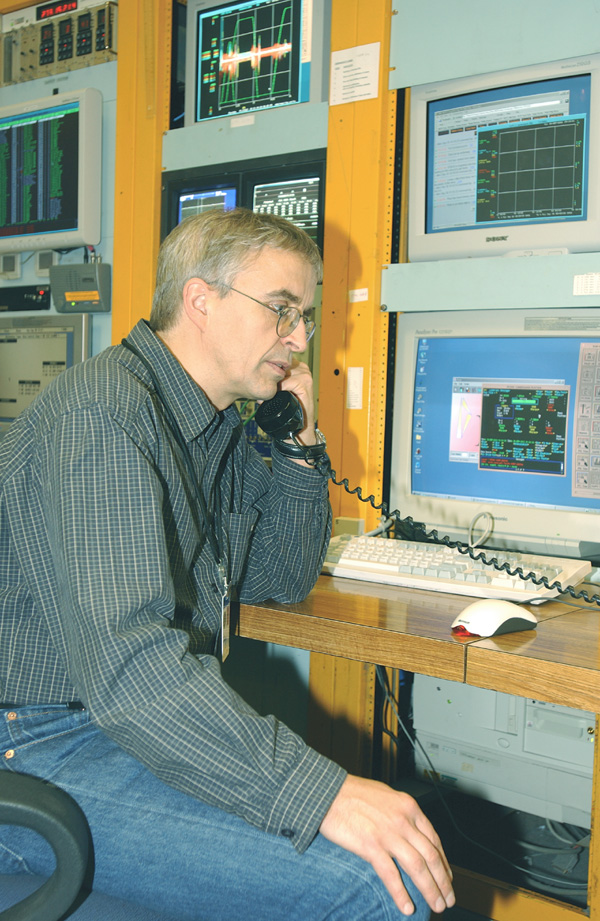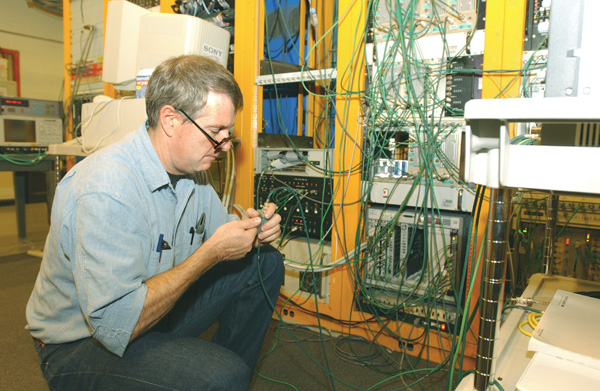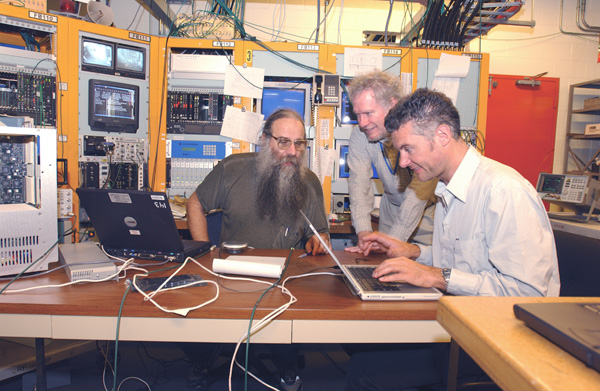 |
|
Helping Hands by Elizabeth Clements In high-energy physics, friends don’t let friends run at low luminosity. And with more than a little help from HEP friends, Fermilab’s Tevatron has set a series of luminosity records, culminating at 8:50 a.m. on Wednesday, October 9. The world’s most powerful particle accelerator achieved an unprecedented luminosity of 3.61 x 1031cm-2sec-1, a measure of the number of high-energy particle collisions per second, also characterized as the beam’s brightness.
In addition the Tevatron set a record for weekly integrated luminosity, the total number of collisions produced in a single week. For the week ending Sunday, October 13, the integrated luminosity reached 6.7 inverse picobarns (pb-1), exceeding previous standards by a wide margin.
The luminosity breakthroughs came at a time when the particle physics world is closely watching Collider Run II of the Tevatron, the world’s best opportunity for particle physics discoveries at the energy frontier for much of the next decade. Collision rates at the proton-antiproton accelerator have been slow to reach anticipated levels since Run II began in March 2001. But the Oct.9 record brought the accelerator significantly closer to its near-term luminosity goal of 4.0 x 1031cm-2sec-1. Reaching this goal requires not only Fermilab ’s best efforts, but also physicists from outside the laboratory to lend a hand. Indeed, if there is a silver lining in the struggle to reach the Tevatron’s luminosity potential, it is the opportunity for collaboration and pooled insights among the world’s experts in accelerator physics and technology.
Fermilab has called on its friends for help, and friends have answered the call from around the world: from nearby Argonne National Laboratory, from Stanford Linear Accelerator Center in California, from Brookhaven National Laboratory in New York, from Lawrence Berkeley Laboratory in California, and from CERN,the European Particle Physics Laboratory in Geneva, Switzerland.
Scientist Yunhai Cai of SLAC is developing simulations of beam effects in the Tevatron to help elucidate the lifetime of the accelerator’s particle beams. Physicist Marc Ross, also from SLAC, is providing electronics to facilitate beam transfers between links in the accelerator chain. Ross describes the collaboration between Fermilab and SLAC as a “perfect marriage” because both groups speak the same language of accelerator science.
“It is to my benefit to get to know people at Fermilab and to understand the problems of the Tevatron,” Ross said.“The technology and science of what people do is unique here, and I am fascinated by that. The collecting of antiprotons, and treating them gingerly because they are so delicate, is fascinating. I hope that we can have a positive impact on the Tevatron,and we realize that a lot of people have been working hard on Run II.”
Argonne National Laboratory is working with the Tevatron Department to develop a plan to improve the vacuum in the Tevatron by a factor of two. Argonne scientists are also studying the need for beam diagnostics to improve proton beam stability as well as beam stability in one of the Tevatron’s feeder accelerators. An accelerator expert, Wolfram Fischer of Brookhaven Laboratory, recently spent a month at Fermilab to help analyze Tevatron performance.
CERN sent Frank Schmidt to Fermilab for six weeks to work with the Tevatron and to take shifts in the control room. Despite the setbacks of Run II, Schmidt maintains a positive attitude.“This is a very hard-working team here, and [the collider run ] is moving along well,” Schmidt said.“I still think that the intermediate goals of Run II can be reached.” On his last day in the main control room, Schmidt reflected on his visit at Fermilab. CERN’s Large Hadron Collider will take over the energy frontier from the Tevatron later this decade, but Schmidt emphasized the importance of the machines feeding off each other’s success.
“I would like to come back to Fermilab,” Schmidt said.“It is fun and important for Large Hadron Collider people to learn from the Tevatron. The success of the Tevatron is an issue for the world community in accelerator physics.” He added jovially,“Let’s see who finds the Higgs first!” Additional visitors from CERN are expected at Fermilab in the upcoming months. And just as CERN has sent physicists to contribute to Run II, Fermilab plans to return the favor by sending Fermilab scientists to CERN to contribute to the commissioning of the Laboratory’s Large Hadron Collider when it comes online later in the decade. Meanwhile,discussions continue with the Department of Energy’s Berkeley Lab about how their world-class accelerator expertise might lend Tevatron support. Each hard-won increase in the Tevatron’s luminosity represents more data for Fermilab experiments CDF and DZero — and a greater chance for discoveries in Run II that will change the understanding of particle physics. The world’s high-energy laboratories are not only watching with interest but are also providing invaluable help.
“It has been extremely gratifying to be fielding offers of support from other labs,” said Steve Holmes, Fermilab’s Associate Director for Accelerators and Interim Head of the Beams Division.“It really shows us that there is a widespread feeling that this endeavor is important to everybody, not just Fermilab. We have a lot of experience here, but there are also strong capabilities outside. And new eyes on the collider often provide insights to help us overcome our problems. The most important thing is that people really want to rally around and help the Tevatron.” After all, that’s what friends are for.
ON THE WEB: |
![Frank Schmidt,an accelerator physicist from CERN,(left) and Dean Still of Fermilab’s Tevatron Department,(right) took shifts together in the main control room at Fermilab.“This is a very hard-working team here, and [the collider run] is moving along well,” Schmidt said.](schmidt1.jpg)



